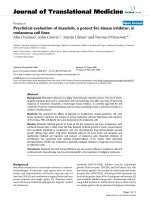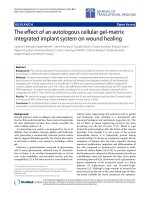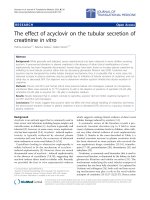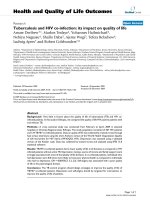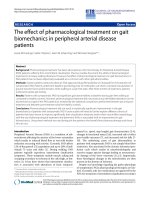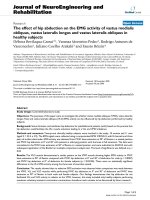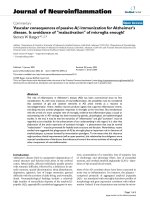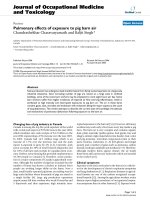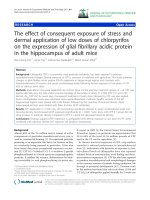báo cáo hóa học:" Five-year effect of community-based intervention Hartslag Limburg on quality of life: A longitudinal cohort study" ppt
Bạn đang xem bản rút gọn của tài liệu. Xem và tải ngay bản đầy đủ của tài liệu tại đây (238.86 KB, 7 trang )
RESEARCH Open Access
Five-year effect of community-based intervention
Hartslag Limburg on quality of life: A longitudinal
cohort study
Saskia PJ Verkleij
1*
, Marcel C Adriaanse
1
, WM Monique Verschuren
2
, Eric C Ruland
3
, Gerrie CW Wendel-Vos
2
,
Albertine J Schuit
1,2
Abstract
Background: During the past decade, quality of life (QoL) has become an accepted measure of disease impact,
therapeutic outcome, and evaluation of interventions. So far, very little is known about the effects of community-
based interventions on people’s QoL. Therefore, the effect of an integrative cardiovascular diseases community-
based intervention programme ‘Hartslag Limburg’ on QoL after 5-years of intervention is studied.
Methods: A longitudinal cohort study comparing 5-year mean change in QoL between the intervention (n =
2356) and reference group (n = 758). QoL outcomes were the physical and mental health composite scores (PCS
and MCS) measured by the RAND-36. Analyses were stratified for gender and socio-economic status (SES).
Results: After 5-years of intervention we found no difference in mean change in PCS and MCS between the
intervention and reference group in both genders and low-SES. However, for the moderate/high SES intervention
group, the scales social functioning (-3.6, 95% CI:-6.1 to -1.2), physical role limitations (-5.3, 95% CI:-9.6 to -1.0),
general mental health (-3.0, 95% CI:-4.7 to -1.3), vitality (-3.2, 95% CI:-5.1 to -1.3), and MCS (-1.8, 95% CI:-2.9 to -0.6)
significantly changed compared with the reference group. These differences were due to a slight decrease of QoL
in the intervention group and an increase of QoL in the reference group.
Conclusion: Hartslag Limburg has no beneficial effect on people’s physical and mental QoL after 5-years of
intervention. In fact, subjects in the interventio n group with a moderate/high SES, show a decrease on their mental
QoL compared with the reference group.
Introduction
During the past decade there has been growing interest
in measuring people’s quality of life (QoL). Traditionally,
outcome measurements in health care have mostly been
determined by objective medical evaluation [1]. The
interest in assessing QoL stems from recognition of the
importance of patients’ own perception of their health
status and well-being. QoL has beco me an accepted
measure of disease impact, therapeutic outcome, and
evaluation of interventions.
Chronic diseases often affect people’ s QoL. Resea rch
shows that people with diabetes mellitus type 2, obesity,
and cardiovascular diseases (CVD) have an decre ased
QoL [2-5]. Moreover, people with favourable levels of
CVD risk factors have greater longevity and tend to
have a better QoL [2]. Therefore, health promotion may
notonlystimulateahealthylifestylebutmayalso
improve people’s QoL. A widely advocated strategy in
public health is community-based health promotion.
In 1998, a community-based CVD prevention program
was initiated in the Netherlands, in the Maastricht
region of the province of Limburg. The goal of Hartslag
Limburg, Dutch for Heartbeat Limburg, is to reduce the
CVD risk by a reduction in fat intake, an increase in
physical activity, and smoking cessation [6-9]. Hartslag
Limburg and other community-based prevention pro-
grams have been proven effective in reducing cardiovas-
cular and lifestyle risk factors [9-12]. However, until
now the effects of community-based interventions on
* Correspondence:
1
Department of Health Sciences VU University, Amsterdam, the Netherlands
Full list of author information is available at the end of the article
Verkleij et al. Health and Quality of Life Outcomes 2011, 9:11
/>© 2011 Verkleij et a l; licensee BioMed Cent ral Ltd. This is an Open Access article distributed under the terms of the Creative Commons
Attribution License ( y/2.0), which permits unrestricted use, distribution, and reproduction in
any medium, provided the original work is properly cited.
people’ s QoL are not known. This is striking because
QoL is a clinically important outcome of people’sper-
spective on well-being. Therefore, the aim of the present
study was to investigate t he effect of Hartslag Limburg
on QoL after 5-years of intervention.
Methods
Hartslag Limburg
In 1998, the community-based intervention project
Hartslag Limburg started. The aim of the project was to
decrease the prevalence of CVD in the general popula-
tion of the Maastricht region (po pulation 185,000) by
encour aging the inhabitants to become physically active,
reduce their fat intake, and qu it smoking. Hartslag Lim-
burg, incorpo rated two strategies: 1) a population strat-
egy aimed at all inhabitants and specifically at low SES
groups, and 2) a high-risk s trategy focusing on indivi-
duals diagnosed with CVD or multiple CVD risk factors
(e.g. hypertension, cholesterol, and overweight) [9]. The
main partners in the community project are the city
councils of Maastricht and four adjacent municipalities,
the Regional Public Health Institute Maastricht (RPHI),
two community social work organizations, and the
regional community healthcare organization. Collabora-
tion among these partners is achi eved through nine
local health committees that organize activities which
promote and facilitate healthy lifestyles. From 1999 until
2003, a total of 790 interventions have been implemen-
ted, of which 590 were major interventions (193 diet,
361 physical activity, and 9 antismoking). Almost 50% of
the interventions took place in low-income areas. Exam-
ples of activities include computer-tailored nutrition
education, nutrition education tours in supermarkets,
public-private collaboration with the retail sector, televi-
sion programs, food labeling, smokefree areas, creating
walking and bicycling clubs, walking and cycling cam-
paigns, and a stop-smoking campaign, in addition to
commercials on local television and radio, newspaper
articles, and pamphlet distribution. A more detailed
description of the project is available elsewhere [8].
Ethics approval
This study was approved on 18 August 1998 by the
Dutch Medical Ethics Committee TNO. Chairman of
committee: Dr. C.H.M. Kleemans. Letter of reference;
CO/TW 2599/10049.
Study population
In this study, a cohort design was used to investigate
the effect of the intervention. Changes observed in the
intervention group were compared with changes in a
reference group. The study population of both inter-
vention and reference area o riginated from two former
monitoring studies conducted by the Dutch National
Institute for Public Health and the Environment
[13,14].
The source population of the intervention region con-
sisted of 13,184 men and women. From this group a
gender- and age-stratified sample of 4,500 subjects was
selected. This was done because the aim was to include
at total of 3,000 subjects in the baseline measurement.
A response rate of at least 65% was anticipated based on
previous experiences. Of the selected 4,500 sample, 441
men and women were excluded because they had
moved to another region. The remaining 4,059 subjects
were invited to participate. 3,232 (80%) whished to par-
ticipate in the study, but for economical and logistical
reasons we were forced to include 3,000 subjects only.
So the remaining 232 subjects that reported their inter-
est in the study were excluded after the 3000 was
reached. Of these 3,000 subjects, 2,414 (81%) partici-
pated in the 5-year follow-up measurement in 2003. In
order to standardize the difference in age range in the
two populations, participants younger than 30 years
were excluded (n = 58) from the intervention popula-
tion. Therefore, we analysed the data of 2,35 6 subjects
from the intervention region.
The source population in the reference region was
smaller, and for thi s reason all subjects were included in
the study. These subjects participated in an ongoing
cohort (the Doetinchem cohort), in which all partici-
pants were physically examined in 1998 and 2003. In
1998, a total of 1,115 were invited, of which 895 subjects
participated (80%). Of these 895 subjects, 758 subjects
(85%) participated in the follow-up measurement in
2003.
In total, analyses were performed on a population of
3,114 (2,356 in the intervention region and 758 in the
reference region) men and women aged 31 to 70 years.
Participants from both the reference and intervention
areas were informed t hat the aim of the study was to
monitor change in risk factors in adults over a 5-year
period. Thus, they were not aware of the underlying aim
of the present study. The study population has been
described in more detail elsewhere [9].
Data Collection
The measurements performed in the intervention and
reference group co nsisted of identical standardized
methods. In the reference area, data collection started in
January an d lasted until December of the same year. I n
the intervention area, data collection started in August
(same year as reference group) and lasted until February
the next year. The measurements included a physical
examination at the Regional Public Health Institute and
a self-administered questionnaire. The staff that per-
formed the physical examination in the intervention
region was not blinded for the goal of the study, but
Verkleij et al. Health and Quality of Life Outcomes 2011, 9:11
/>Page 2 of 7
they were una ware of the values of the pre-intervention
measurement when conducting the post-intervention
measurement. The self- administered questio nnaire con-
sisted of questions on demographics, health status, QoL,
current smoking, physical activity, diet, and chronic dis-
eases. During the physical examination, blood pressure
(systolic and diastolic), height, weight, waist circumfer-
ence, and total and HDL cholester ol concentration were
measured.
Quality of life
QoL was measured by the Dutch version of the RAND-
36 Health Survey (RAND-36) [15], which was translated
from the standardized SF-36 Health Survey [16]. The
RAND-36 consists of 36 questions which c omprises of
eight multi -item scales: physical functioning, social func-
tioning, role limitations due to physical health problems,
role limitations due to emotional problems, general men-
tal health, vitality, bodily pain, and general health percep-
tion. In addition, two summary scores representing
physical (PCS) and mental health (MCS) are generated.
All scales were s cored from 0 to 100, with higher scores
indicating a better QoL [17]. The RAND-36 is a vali-
dated, reliable, and responsive measure with good psy-
chometric properties [18]. The RAND-36 comprises of
the same items as the SF-36 [19], however, the methodol-
ogy to derive the final scores is different, but the effect on
the final score is minimal [16]. It is suggested that a mini-
mum of three to five points difference on any given scale
may be considered clinically important [20].
Risk factors and diseases
Socio-economic status (SES) was defined by the highest
level of education that was completed. Education was
measured on a nine-point ordinal scale ranging from
elementary school to c ompleted university. Low socio-
eco nomic status was defined as lower vocational or pri-
mary school. Current smoking status was assessed by
asking the respondents whether they had smoked the
last seven day (yes/no). Participants that indicated that
they did smoke were categorized as smoker. Body mass
index (BMI) was calculated as weight divided by height
squared (kilograms per square meter). In this calculation
one kilogram was subtract ed from the measured weight,
in order to adjust for the light indoor clothing. Presence
of diseases at baseline was based on self-reported preva-
lence of one of the following diseases: myocardial infarc-
tion, stroke, cancer, or diabetes mellitus type 2. The
occurrence of diseases between baseline and follow-up
is determined by the absence of a disease at baseline
and the self-reported presence of one or more of the
above mentioned diseases at follow-up.
Statistical analysis
Descriptive data (means, standard deviation, and percen-
tage) of the baseline characteristics of the intervention
and reference population were presented for men and
women separately. First, differences in study sample
characteris tics of the intervention and reference popula-
tion by sex were examined using Students t-test for con-
tinuous variables and c
2
-tests for categorical variables.
Next, the effect of Hartslag Limburg on QoL was inves-
tigated by comparing change in the two summary
RAND-36 scores, PCS and MCS, between the interven-
tion group and the reference group using regressio n
analyses. The dependent variable is change in PCS and
MCS. Group status (intervention/reference) is the inde-
pendent variable. The analyses were pe rformed sepa-
rately for men and women and adjusted for age, SES,
presence of chronic diseases at baseline, oc currence of
chronic diseases between baseline and follow-up, and
mean of baseline and follow-up measurement of t he
variable under study. This last adjustment was done to
neutralize possible effects of regression to the mean
[21]. Finally, since Ha rtslag Limburg has a specific focus
on low-SES groups, additional regression analyses were
also stratified for SES. For all statistical testing, we used
two-sided hypothesis testing with an alpha level of <
0.05. Data were analysed using SAS software version 9.1.
Results
Study population
Baseline characteristics of men and women measured in
1998 for the intervention and the reference population
who completed follow-up in 2003 are shown in Table 1.
Mean age of both populations was approximately 51
years. There w ere no significant differences in baseline
characteristics in women between the two populations.
However, men in the intervention group were younger,
scored significantly lower on prevalence of cancer, vital-
ity, and general health perception than men in the refer-
ence group. Additional analysis showed that at follow-up,
responders (n = 3,114) (the total number of subjects with
a pre- and post intervention measurement (intervention
n = 2,356 and control n = 758)) compared with non-
responders (n = 682) scored higher on baseline PCS (50.4
vs. 49.0) and MCS (50.3 vs. 48.9), whereas no differences
were found regarding age, gender, and SES.
Effect on QoL after 5-years
The mean and adjusted difference in change i n QoL
among men and women in the intervention and the
reference group after 5-years of intervention are pre-
sented in Table 2. After 5-years of i ntervention we
foundnodifferenceinmeanchangeinbothPCSand
MCS between the intervention and reference group
across gender. For women, the differences between
intervention and reference group were significant on the
subscales social functioning (mean change between
intervention and reference group -4.3, 95% CI: -6.9 to
Verkleij et al. Health and Quality of Life Outcomes 2011, 9:11
/>Page 3 of 7
-1.7), vitality (-3.0, 95% CI: -4.9 to -1.1), and bodily pain
(-2.8, 95% CI: -5.5 to -0.2). For men there were no sig-
nificant differences between the intervention and the
reference group on any of the eight subscales, nor on
the summary PCS and MCS scales.
Social economic status
The mean change and adjusted difference in change in
QoL among low and moderate-high SES groups in the
intervention and refer ence group after 5-years of inter-
vention are presented in Table 3. In the low SES
Table 1 Baseline characteristics stratified by sex of intervention and reference population (1998) who completed
follow-up in 2003
Men Women
Intervention
(n = 1187)
Reference
(n = 349)
Intervention
(n = 1169)
Reference
(n = 409)
Demographics
Age (years) 50.6 (9.8)* 52.2 (9.9) 50.6 (9.7) 51.3 (10.4)
Low socio-economic status (%) 44.6 43 60.7 61.3
Current smoking (%) 23.9 24.7 26.7 22
BMI
a
overweight
b
(%) 64 60 48 51
Diseases (self reported)
Myocardial infarction (%) 3.1 3.4 0.7 0.7
Stroke (%) 0.8 0.6 0.6 1.0
Cancer (%) 2* 4 4.2 5.6
Diabetes mellitus (%) 2.9 1.4 1.5 2.2
Quality of Life
Physical functioning (PF) 89.2 (15.5) 89.7 (16.0) 85.0 (17.7) 85.9 (18.6)
Social functioning (SF) 88.6 (19.0) 90.2 (16.4) 84.7 (21.0) 82.6 (21.9)
Role limitations physical (RP) 86.8 (28.6) 86.9 (27.2) 80.2 (35.2) 78.9 (34.7)
Role limitations emotional (RE) 89.4 (26.8) 91.3 (22.7) 85.4 (31.9) 85.4 (31.1)
General mental health (MH) 78.7 (15.6) 80.0 (13.5) 73.3 (16.9) 74.3 (15.1)
Vitality (VT) 68.9 (17.6)* 70.9 (15.8) 63.5 (18.3) 63.5 (16.9)
Bodily pain (BP) 84.7 (21.0) 86.7 (18.2) 79.5 (23.4) 78.2 (21.5)
General health perception (GH) 69.5 (17.2)* 72.7 (15.9) 68.1 (18.1) 69.4 (17.2)
MCS
a
51.3 (9.0) 52.2 (7.9) 49.1 (10.0) 49.0 (9.5)
PCS
a
51.0 (7.4) 51.5 (7.4) 49.6 (8.9) 49.5 (9.1)
*Difference between intervention and reference group (p < 0.05) (bolded). Data presented as mean (SD) or as percentage.
a
BMI, Body mass index; MCS, Mental Health Composite score of RAND-36; PCS, Physical Health Composite score of RAND-36.
b
Overweight was defined as body mass index of ≥ 25 kg/m
2
.
Table 2 Mean change in QoL
a
by sex after 5-years of intervention
Quality of Life Men Women
Intervention Reference Adj difference
b
(95% CI)
c
Intervention Reference Adj difference
b
(95% CI)
c
PF
a
-0.6 -1.7 0.7 (-1.0 to 2.4) -1.6 -2.3 0.7 (-1.1 to 2.5)
SF
a
-0.9 -0.1 -0.9 (-3.3 to 1.5) -0.9 3.4 -4.3* (-6.9 -1.7)
RP
a
-2.0 0.3 -2.7 (-6.7 to 1.3) -3.7 0.4 -4.1 (-8.7 to 0.6)
RE
a
-1.0 0.3 -1.2 (-5.0 to 2.6) -0.4 0.0 -0.3 (-4.7 to 4.0)
MH
a
-0.5 1.0 -1.5 (-3.1 to 0.2) 0.0 1.5 -1.6 (-3.3 to 0.2)
VT
a
-0.4 0.0 -0.5 (-2.4 to 1.5) -0.5 2.5 -3.0* (-4.9 to -1.1)
BP
a
-1.6 -3.6 1.7 (-0.8 to 4.3) -2.4 0.4 -2.8* (-5.5 to -0.2)
GH
a
-2.6 -3.7 0.9 (-0.9 to 2.6) -2.8 -2.3 -0.8 (-2.5 to 1.0)
MCS
a
-0.2 0.7 -0.8 (-1.8 to 0.3) 0.2 1.3 -1.1 (-2.3 to 0.1)
PCS
a
-0.7 -1.3 0.5 (-0.4 to 1.4) -1.2 -0.7 -0.6 (-1.5 to 0.4)
*Difference between intervention and reference group (p < 0.05) (bolded).
a
QoL, quality of life; PF, physical functioning; SF, social functioning; RP, role limitations physical; RE, role limitations emotional; MH, general mental health; VT,
vitality; BP, bodily pain; GH, General health perception; MCS, Mental Health Composite score of RAND-36; PCS, Physical Health Composite score of RAND-36.
between baseline and follow-up, and the mean of baseline and follow-up of the variable under study.
b
Adjusted difference in change between the intervention and the reference group for age, level of education, presence of self reported diseases (myocardial
infarction, stroke, cancer, diabetes mellitus) at baseline (1998), occurrence of diseases (myocardial infarction, stroke, cancer, diabetes mellitus).
c
95% CI, 95% confidence interval.
Verkleij et al. Health and Quality of Life Outcomes 2011, 9:11
/>Page 4 of 7
intervention group (n = 1,239), physical functioning
decreased significantly less (1.9, 95% CI: 0.0 to 3.8) dur-
ing follow-up compa red with the reference group (n =
401). For the moderate or high SES intervention group
(n = 1,117), the scales social functioning (-3.6, 95% CI:
-6.1 to -1.2) , physical role limitations (-5.3, 95% CI: -9.6
to -1.0), general mental health (-3.0, 95% CI: -4.7 to
-1.3), vitality (-3.2, 95% CI: -5.1 to -1.3), and MCS ( -1.8,
95% CI: -2.9 to -0.6) signif icantly changed compared
with the reference group (n = 357). These differences
were due to a slight decrease of QoL in the intervention
group compared with a slight increase of QoL in the
reference group.
Discussion
This study focused on exploring the effect of a commu-
nity-based prevention program on people’s QoL. This is,
to our best knowledge, the first study that prospecti vely
determined the ef fect of a CVD community- based inter-
vention (Hartslag Limburg) on people’s QoL. We con-
cluded that Hartslag Limbur g has no beneficial eff ect on
people’s physical and mental QoL after 5-years of inter-
vention. Only for women, differences between i nterven-
tion and reference group were significant for the
subscales social functioning, vitality, and bodily pain. In
fact, subjects in the moderate/high SES intervention
group, show a decrease on their mental health compo-
site score compared with the reference group. These dif-
ferences were due to a slight decrease of QoL subscales
social functioning, general mental health and vitality in
the moderate/high SES intervention group and an
increase of those three QoL subscales in the reference
group.
Several outcomes of the effects of the program Hartslag
Limburg have already been reported. Hartslag Limburg
was not effective in changing smoking behaviour [22],
but was effective in reducing other cardiovascular and
lifestyle risk factors (e.g. BMI, blood pressure, energy
intake, and time spent on walking) [ 9,12]. In this study,
we anticipated a small decrease in the QoL in both
groups (due to ageing), being less pronounced in the
intervention group. However, this was not observed. On
thecontrary,thepresentstudyfoundanon-significant
tendency for a reduction in QoL in the intervention
group, and an improvement of QoL in the cont rol group
(six of the eight scales for women and four of the eight
scales for men). Apparently the beneficial changes in
CVD risk factors associated with the intervention
Table 3 Mean change in QoL among low and moderate-high SES
a
groups after 5-years of intervention
QoL Low SES
a
Moderate or high SES
a
Baseline
I
a
(n = 1239)
Baseline
R
a
(n = 401)
Mean change
I
a
Mean change
R
a
Adj. diff
b
(95% CI)
c
Baseline
I
a
(n = 1117)
Baseline
R
a
(n = 357)
Mean change
I
a
Mean change
R
a
Adj diff
b
(95% CI)
c
PF
a
83.8 (18.6) 85
(20.1)
-0.9 -3.1 1.9*
(0.0 to 3.8)
90.9 (13.4) 90.6 (13.7) -1.2 -0.8 -0.7
(-2.3 to 0.8)
SF
a
84.8 (21.6) 84.2 (21.2) 0.2 1.9 -1.9
(-4.4 to 0.6)
88.9
(18)
88.2 (18.1) -2.1 1.6 -3.6*
(-6.1 to -1.2)
RF
a
80.7
(34)
81.1 (34.1) -2.2 -0.9 -1.8
(-6.2 to 2.6)
86.9 (29.6) 84.3 (28.8) -3.4 1.7 -5.3*
(-9.6 to -1.0)
RE
a
86
(31)
87.9 (28.1) 0.0 -1.4 1.3
(-2.8 to 5.3)
89.2 (27.3) 88.4 (27.2) -1.6 1.8 -3.2
(-7.4 to 0.9)
MH
a
74.2 (17.4) 75.3
(15.8)
0.2 0.4 -0.2
(-2.0 to 1.5)
78.2 (14.8) 78.7 (13.1) -0.8 2.3 -3.0*
(-4.7 to -1.3)
VT
a
64.7 (18.8) 65.6 (17.1) -0.2 0.3 -0.6
(-2.5 to 1.4)
68
(17.2)
68.4 (16.4) -0.7 2.4 -3.2*
(-5.1 to -1.3)
BP
a
79.5 (23.7) 79.5 (22.6) -1.8 -1.1 -0.7
(-3.4 to 1.9)
85.1 (20.3) 85
(17.4)
-2.3 -1.8 -0.6
(-3.1 to 2.0)
GH
a
66.8 (18.1)* 68.9 (17.9) -2.8 -3.1 0.0
(-1.7 to 1.8)
71.2 (16.8)* 73.2
(15)
-2.7 -2.8 0.0
(-1.8 to 1.8)
MCS
a
49.7 (10.1) 50.0
(9.2)
0.4 0.6 -0.2
(-1.3 to 0.9)
50.9
(8.9)
50.9
(8.7)
-0.4 1.5 -1.8*
(-2.9 to -0.6)
PCS
a
49.2
(8.7)
49.4
(9.1)
-0.9 -1.0 0.0
(-0.9 to 1.0)
51.7
(7.4)
51.6
(7.3)
-1.0 -0.9 -0.2
(-1.1 to 0.7)
*Difference between intervention and reference group (p < 0.05) (bolded).
a
SES, socio-economic status; QoL, quality of life; I, Intervention region; R, Reference region; PF, physical functioning; SF, social functioning; RP, role limitations
physical; RE, role limitations emotional; MH, general mental health; VT, vitality; BP, bodily pain; GH, General health perception; MCS, Mental Health Composite
score of RAND-36; PCS, Physical Health Composite score of RAND-36.
b
Adjusted difference in change between the intervention and the reference group for age, gender, presence of diseases (myocardial infarction, stroke, cancer,
diabetes mellitus) at baseline (1998), occurrence of diseases (myocardial infarction, stroke, cancer, diabetes mellitus) and between baseline and follow-up, and the
mean of baseline and follow-up of the variable under study.
c
95% CI, 95% confidence interval.
Verkleij et al. Health and Quality of Life Outcomes 2011, 9:11
/>Page 5 of 7
program did not translate into a better perceived QoL.
Maybe the cardiovascular and lifestyle risk changes were
too modest to influence people’ sQoL.Seasonalitycan
not explain the out come of the s tudy, because the pre-
and post intervention measurement of subjects in inter-
vention and control group took place in the same month.
Research has shown that SES is associated with (self-
rated) health status [23]. Since Hartslag Limburg has a
specific focus on low SES groups, analyses were strati-
fied for SES. Previous analyses showed that Hartslag
Limburg beneficially affected BMI, waist circumference,
blood pressure, energy intake, fat intake, walking, and
bicycling in low SES groups [9,12]. Hen ce, we partic u-
larly anticipated an effect on QoL in this group. H ow-
ever, except for physical functioning no effects were
observed in the low SES group.
Community-based CVD prevention programs are a
widely advocated strategy in public health. So far, no
studies have reported on the effects of community-based
interventions on QoL. There is also limited data on the
effect of health promotion programs and QoL. Compari-
son of outcomes is difficult because of differences in
time periods over which the effects were measured, used
methods, interventions, and stud y populations. Ye t,
there are some related studies that put our results in
perspective. Improvement in the mental component of
QoL has been reported after a cardiovascular lifestyle
mod ification program of one year [24]. Also Lobo et al.
found less impairment in QoL in the intervention group
compared with a control group after an intervention
program of 21 months [25]. The only study that also
did not report a beneficial effect of a lifestyle program
on QoL is the study of Cupples & McKnight, who inves-
tigated the effect of a 2-year health promotion program
five years after enrolment in patients with angina [26].
However, these studies all focused on patients at high
cardiovascular r isk and were based on individually tar-
geted interventions.
The strengths of our study are the longitudinal design,
the use of a reference group, a large sample of subjects,
and a follow-up of 5 years. The large number of partici-
pantsincludedinthisstudyensuresenoughpowerto
detect small differences. Finally, we used the RAND-36,
which is a validated, reliable, and responsive question-
naire to measure QoL [18].
This study also has some limitations that should be
addressed. First, the number and selectiveness of drop-
outs may have biased the results. In our study, respon-
ders scored higher on baseline PCS and MCS compared
with non-responders at the follow-up. No differences
between non-responders and responders w ere found in
age, gender, and SES. In this study however, over 80%
of the subjects completed both the baseline and the
5-year follow-up measurement. So, it is not likely that
drop-out might have changed our results. Second, it is
well known that presence of chronic diseases can nega-
tively effect people’s QoL [3-5]. Therefore , the results of
our study were adjusted for the presence or occurrence
of myocardial infarction, stroke, cancer, and/or diabetes
mellitus type 2. Unfortunately, no information was avail-
able about all chronic diseases (e.g. chronic obstructive
pulmonary disease (COPD), depression and inflamma-
tory bowel diseases). So, we could not control for them.
However, the per centage of people in our study popula-
tion, who are suffering from COPD and/or inflammatory
bowel diseases, would probably be low. So, it is not
likely to influence our results to a great extent.
In summary, this study showed that five years of com-
munity-based prevention did not lead to an improvement
in QoL. In fact, subjects in the intervention group with a
moderate/high SES, show a de crease on their mental
QoL compared with the reference group. Although the
health effects of Hartslag Limburg and other community
based intervention have been previously establish ed, this
study does not provide an indication that these types of
programs should be implemented to favourably improve
the QoL in the general population.
Conclusion
We found that Hartslag Limburg has no beneficial effect
on people’s physical and mental QoL after 5-years of
intervention. No substantial e ffects were observed in
men and women. However, people in the intervention
group with a moderate or high SES had a relative
decrease in mental QoL compared to t heir peers in the
reference group.
Author details
1
Department of Health Sciences VU University, Amsterdam, the Netherlands.
2
National Institute for Public Health and the Environment, Bilthoven, the
Netherlands.
3
Netherlands Institute for Health Promotion and Disease
Prevention, Woerden, the Netherlands.
Authors’ contributions
SPJV prepared the article and performed the data-analyses. MCA contributed
to writing the article. AJS was project leader of Hartslag Limburg and
contributed to writing the article. GCWW performed the project
coordination of Hartslag Limburg and contributed to writing the article. ECR
conceived the study and was project leader. WMMV was project leader of
the Doetinchem cohort. All authors have read and approved the final
version of the article.
Competing interests
The authors declare that they have no competing interests.
Received: 12 March 2010 Accepted: 27 February 2011
Published: 27 February 2011
References
1. Fontaine KR, Barofsky I: Obesity and health-related quality of life. Obes Rev
2001, 2(3):173-182.
2. van Jaarsveld CH, Sanderman R, Miedema I, Ranchor AV, Kempen GI:
Changes in health-related quality of life in older patients with acute
Verkleij et al. Health and Quality of Life Outcomes 2011, 9:11
/>Page 6 of 7
myocardial infarction or congestive heart failure: a prospective study.
J Am Geriatr Soc 2001, 49(8):1052-1058.
3. Hlatky MA, Chung SC, Escobedo J, Hillegass WB, Melsop K, Rogers W,
Brooks MM, Group BDS: The effect of obesity on quality of life in patients
with diabetes and coronary artery disease. Am Heart J 2010,
159(2):292-300.
4. Kleefstra N, Landman GW, Houweling ST, Ubink-Veltmaat LJ, Logtenberg SJ,
Meyboom-de Jong B, Coyne JC, Groenier KH, Bilo HJ: Prediction of
mortality in type 2 diabetes from health-related quality of life (ZODIAC-
4). Diabetes Care 2008, 31(5):932-933.
5. Martinelli LM, Mizutani BM, Mutti A, D’Elia MP, Coltro RS, Matsubara BB:
Quality of life and its association with cardiovascular risk factors in a
community health care program population. Clinics (Sao Paulo) 2008,
63(6):783-788.
6. Harting J, van Assema P, de Vries NK: Patients’ opinions on health
counseling in the Hartslag Limburg cardiovascular prevention project:
perceived quality, satisfaction, and normative concerns. Patient Educ
Couns 2006, 61(1):142-151.
7. Ronda G, Van Assema P, Candel M, Ruland E, Steenbakkers M, Van Ree J,
Brug J: The Dutch Heart Health community intervention ‘Hartslag
Limburg’: results of an effect study at individual level. Health Promot Int
2004, 19(1):21-31.
8. Ronda G, Van Assema P, Ruland E, Steenbakkers M, Brug J: The Dutch
Heart Health Community Intervention ‘Hartslag Limburg’: design and
results of a process study. Health Educ Res 2004, 19(5):596-607.
9. Schuit AJ, Wendel-Vos GC, Verschuren WM, Ronckers ET, Ament A, Van
Assema P, Van Ree J, Ruland EC: Effect of 5-year community intervention
Hartslag Limburg on cardiovascular risk factors. Am J Prev Med 2006,
30(3):237-242.
10. Vartiainen E, Jousilahti P, Alfthan G, Sundvall J, Pietinen P, Puska P:
Cardiovascular risk factor changes in Finland, 1972-1997. Int J Epidemiol
2000, 29(1):49-56.
11. Winkleby MA, Taylor CB, Jatulis D, Fortmann SP: The long-term effects of a
cardiovascular disease prevention trial: the Stanford Five-City Project.
Am J Public Health 1996, 86(12):1773-1779.
12. Wendel-Vos GC, Dutman AE, Verschuren WM, Ronckers ET, Ament A, van
Assema P, van Ree J, Ruland EC, Schuit AJ: Lifestyle factors of a five-year
community-intervention program: the Hartslag Limburg intervention.
Am J Prev Med 2009, 37(1):50-56.
13. Smit HA, Verschuren WMM, Bueno de mesquita HB, Seidell JC: Monitoring
van risicofactoren en gezondheid in Nederland (MORGEN-project):
doelstellingen en werkwijze. Bilthoven: RIVM; 1994.
14. Verschuren WMM, van Leer EM, Blokstra A, Seidell JC, Smit HA, Bueno de
Mesquita HB, Boer Obermann-de GL, Kromhout D: Cardiovascular disease
risk factors in the Netherlands. Neth J Cardiol
1993, 4:205-10.
15. VanderZee KI, Sanderman R, Heyink J: A comparison of two
multidimensional measures of health status: the Nottingham Health
Profile and the RAND 36-Item Health Survey 1.0. Qual Life Res 1996,
5(1):165-174.
16. Hays RD, Sherbourne CD, Mazel RM: The RAND 36-Item Health Survey 1.0.
Health Econ 1993, 2(3):217-227.
17. Koch H, van Bokhoven MA, ter Riet G, van der Weijden T, Dinant GJ,
Bindels PJ: Demographic characteristics and quality of life of patients
with unexplained complaints: a descriptive study in general practice.
Qual Life Res 2007, 16(9):1483-1489.
18. VanderZee KI, Sanderman R, Heyink JW, de Haes H: Psychometric qualities
of the RAND 36-Item Health Survey 1.0: a multidimensional measure of
general health status. Int J Behav Med 1996, 3(2):104-122.
19. Ware JE, Sherbourne CD: The MOS 36-item short-form health survey
(SF-36). I. Conceptual framework and item selection. Med Care 1992,
30(6):473-483.
20. Hays RD, Morales LS: The RAND-36 measure of health-related quality of
life. Ann Med 2001, 33(5):350-357.
21. Oldman PD: A note on the analysis of repeated measurements of the
same subjects. J Chronic Dis 1962, 15:969-977.
22. Ronda G, Van Assema P, Candel M, Ruland E, Steenbakkers M, Van Ree J,
Brug J: The Dutch Heart Health Community Intervention ‘Hartslag
Limburg’: effects on smoking behaviour. Eur J Public Health 2004,
14(2):191-193.
23. Wilkinson RG, Pickett KE: Income inequality and population health: a
review and explanation of the evidence. Soc Sci Med 2006,
62(7):1768-1784.
24. Vizza J, Neatrour DM, Felton PM, Ellsworth DL: Improvement in
psychosocial functioning during an intensive cardiovascular lifestyle
modification program. J Cardiopulm Rehabil Prev 2007, 27(6):376-383, quiz
384-375.
25. Lobo CM, Frijling BD, Hulscher ME, Bernsen RM, Grol RP, Prins A, van der
Wouden JC: Effect of a comprehensive intervention program targeting
general practice staff on quality of life in patients at high cardiovascular
risk: a randomized controlled trial. Qual Life Res 2004, 13(1):73-80.
26. Cupples ME, McKnight A: Five year follow up of patients at high
cardiovascular risk who took part in randomised controlled trial of
health promotion. BMJ 1999, 319(7211):687-688.
doi:10.1186/1477-7525-9-11
Cite this article as: Verkleij et al.: Five-year effect of community-based
intervention Hartslag Limburg on quality of life: A longitudinal cohort
study. Health and Quality of Life Outcomes 2011 9:11.
Submit your next manuscript to BioMed Central
and take full advantage of:
• Convenient online submission
• Thorough peer review
• No space constraints or color figure charges
• Immediate publication on acceptance
• Inclusion in PubMed, CAS, Scopus and Google Scholar
• Research which is freely available for redistribution
Submit your manuscript at
www.biomedcentral.com/submit
Verkleij et al. Health and Quality of Life Outcomes 2011, 9:11
/>Page 7 of 7
